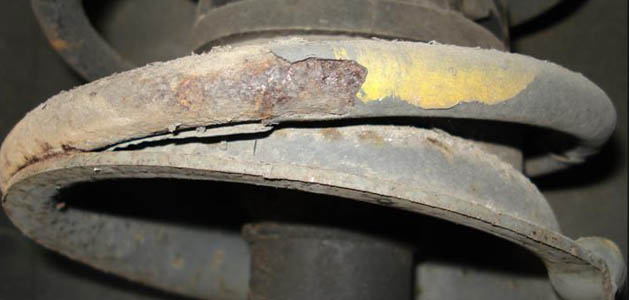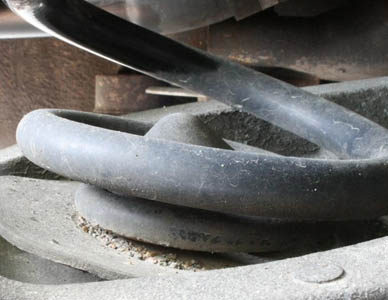
The MOT Testing Manual includes some valuable advice for the tester when it comes to inspecting the state of the coil-spring and its mountings. Section 2.4.C discusses in some detail how coil-springs should be checked for general condition, cracks and fractures. Attention is also given to checking that the spring is correctly located in the spring mounts and also the condition of the mounts themselves.
In the line of fire
The proliferation of lightweight, high stress designs coupled with local councils’ eagerness to spread salt at the first sign of frost and the popularity of the speed bump as a means to calm the rushing motorist means that some coil-springs will last only a couple of winters at most.
Automotive road springs are highlystressed components. Their position underneath the car means they operate in a particularly aggressive environment. Road debris – small stones and grit – thrown up by the tyre, strike the exposed coil-spring with such force that the surface coating may become damaged, revealing bare steel which quickly rusts. Minute cracks are quick to form on this rusty, pockmarked surface and, because cyclic loading assists crack propagation, a crack will grow every time the car rides over a bump. In addition, and despite efforts by the vehicle manufacturers to prevent it, road debris can collect in the lower spring pan.
In wet conditions, water mixes with the debris which can remove the protective coating from the spring – the reason why many automotive road springs, even those on relatively new cars, have some rust on the bottom coil. As winter arrives, the situation worsens. Cold temperatures affect the toughness of the steel; simply put, the steel becomes more brittle and is more liable to cracking. Road salt, mixed with water, is damaging to the coil-spring once the surface coating has broken down and dramatically accelerates the corrosion process. It is not uncommon for coil-springs to fail catastrophically on a cold winter’s morning; the shock impact of the car’s road wheel descending a kerb or negotiating a speed bump is often sufficient to cause that tiny crack to propagate quite audibly across the full diameter of the spring wire.

Corrosion of the end coil is common. This image shows that catastrophic failure is imminent.
In the workshop
Mechanics should pay close attention to coilsprings whenever they have a vehicle in for a service. Closely inspect the condition and fitment of the coil-spring, especially at the juncture where it meets the lower spring pan. Check also that springs on the same axle are of the same design. Some OE springs are manufactured from taper wire – the wire at the spring end has a smaller diameter than in the main body of the spring – and we strongly recommend replacing ‘like-for-like’ to retain the balance of the car and ensure customer satisfaction.
Remove any debris
A good lamp will be required to check the condition of the lower coil where it sits in the spring pan but never look for cracks or fractures by feeling with your fingers as the forces between the spring and the spring pan can be very high. Take this opportunity to remove any road debris from the lower pan because this will help to prevent premature failure. Springs that show any sign of corrosion should be replaced because although they can fail at any time, this is unlikely to happen in the workshop.
Road debris and very high frictional forces have removed the surface coating from the end coil of this Miniblock spring.










